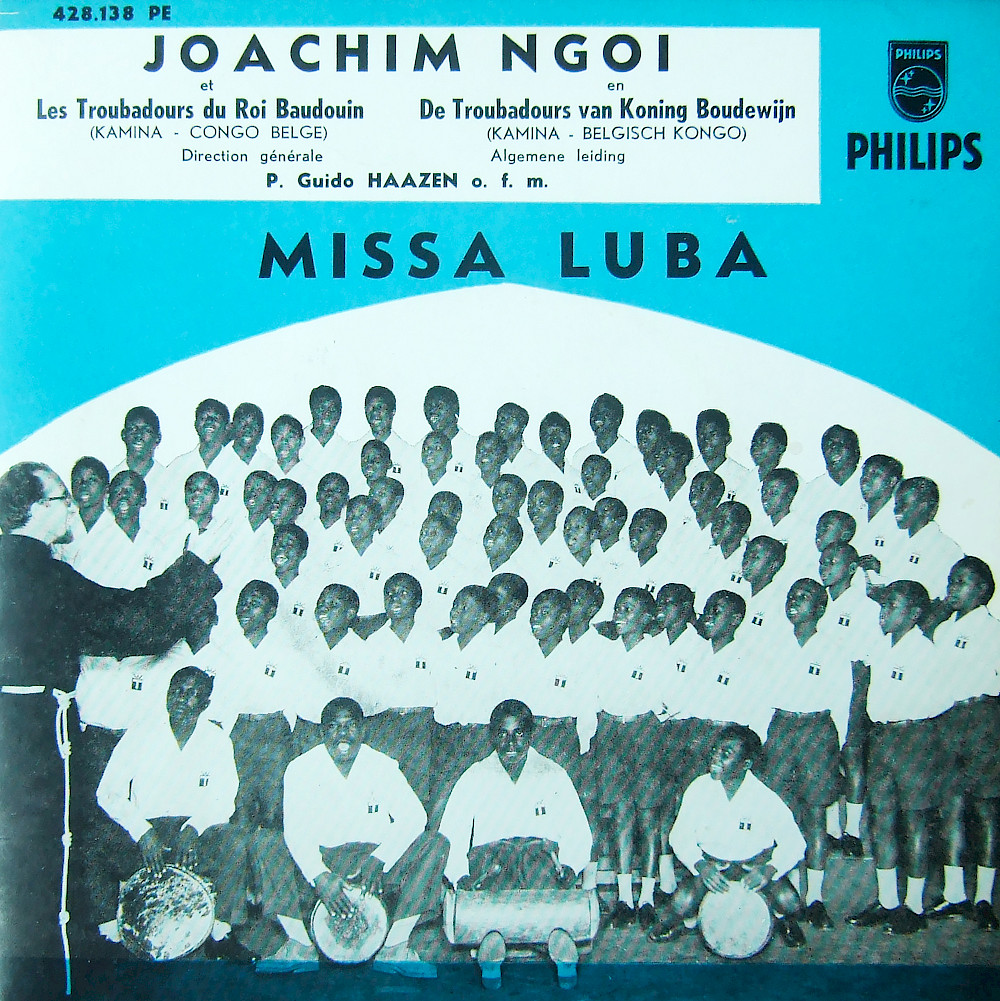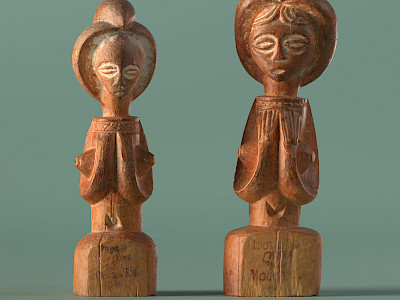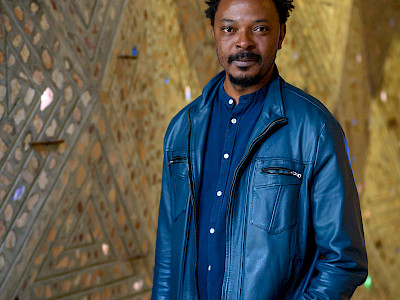29.05 — 01.06.2024
The first Black bishop te be appointed by the Catholic Church was supposed to settle in Utica, Tunisia but never arrived there. In this new creation, Sammy Baloji retraces the priest's journey. Missa Utica plunges us into the history of slavery, the Kongo Kingdom of the 15th century and the evangelisation of Africa. The project is inspired by the Missa Luba, a Latin mass developed by a 20th-century Belgian missionary, using traditional Congolese songs. This music is reinterpreted by Barbara Drazkov and Pytshens Kambilo, becoming a dialogue of friction between classical European music and Congolese rumba. We witness first contact and diplomatic exchange, alliance and misalliance, becoming sharply aware of colonial strategic issues and enslavement. We see Africa’s colonised past collide with current political and economic reality. The narrative of actress Bwanga Pilipili presents several tableaux imagining a mass filled with the iconography of great Congolese heroes. Under the Mercerie’s impressive glass roof and on a large carpet woven in Tunisia, Baloji’s installation shows disparate territories and histories across pre- and post-colonial eras finally reconnected.
Missa Utica
The first encounter between Congolese and European Christians took place at the end of the 15th century, few years before Columbus landed in America. Diogo Cão, a Portuguese naval captain, arrives to the mouth of the Congo River in 1483. At that time Kongo Kingdom is ruled by a sovereign Nzinga a Nkuwu and consisted of the southern part of Congo Brazzaville, the north of Angola, as well as the southwest of Congo DRC, and part of Gabon. In the Congolese cosmogony of that time, the ancestors were believed to reside in the depths of the ocean. Convinced that they witness their return, the Congolese warmly welcomed the European ships.
The diplomatic relations between Portugal and Kongo flourished at the beginning of 16th century, during the rule of Mvemba a Nzinga (baptized as Dom Afonso Ier, 1456-1543). In contrary to his father Nzinga a Nkuwu (baptized as Dom João Ier), who eventually commits apostasy, Dom Afonso declares the Christianity as official state religion which would supposedly lead to a fast modernization of his country.
Son of this illustrious king: Kinu A Mvemba, baptized as Dom Henrique (1495-1531), was meant to realize his father’s demand for an indigenous clergy and a Christian-educated social class in the first Christian kingdom in Africa. He was sent to Lisbon in 1506 to study theology followed by several other young Kongo elites who were sent during the reign of Afonso I to be trained in Europe, with varying fortunes (most of them died once in Europe). Dom Henrique stayed there until 1521 after receiving an education at the monastery of Saint Eloi where he studied Latin and theology.
On May 5, 1518, Pope Leo X appointed Prince Dom Henrique as Bishop of the ancient city of Utica In partibus infidelium (in the lands of the infidels). Formerly prosperous Phoenician and later Roman port, located near Carthage (currently Tunisia), in 16th century was already almost vanished. While Dom Henrique would never make it to the ruins of Utica, he was one of the political assets of his father, protégé of King Manuel I of Portugal and the first indigenous bishop of black Africa. He returned to Mbanza Kongo and was appointed governor of the province of Mpangu in addition to his episcopal office. In this double capacity, he was the second most important political figure in Congo after the king.
In the following centuries, the Christianization intensifies, despite the resistance of some inland populations, and it becomes a crucial actor in the economic exploitation of Congo and especially in slave trade, which developed spectacularly, with the support of the Latin Church. From 1530, more than 5,000 slaves were sent each year to the other side of the Atlantic. In 16th century this number raised to 15,000 slaves annually.
At the beginning of 18th century, the Kongo Kingdom was tormented by civil wars caused by succession conflicts and by the Portuguese, who were trying to conquest entirely the territory where they have been practicing the slave trade for very long.
In the context of this chaotic times, appears the prophet figure of Kimpa Vita. Coming from an aristocratic family she was a former priestess of the Marinda cult, that at the age of 20 had a revelation with Saint Anthony of Padua, who passed her a divine mission of reunification of the kingdom around its ancient capital São Salvador, new Jerusalem. It becomes a foundation of “Antonianism”, a syncretic movement where the traditional beliefs of Kongo are mixed with the teachings of the Catholic Church, adding a discourse of black pride called to a great future. She offers its followers an Africanization of Christianity by rejecting the sign of crucifix and highlighting the importance of local saints. She describes the European Catholic missionaries as Ndokis, “sorcerers”. Around 80,000 converts followed her, causing great concern among the Catholic establishment, who eventually calls the Antonianism a witchcraft and accuses Kimpa Vita of heresy. She dies burnt at the stake in 1706 and quickly becomes a martyr prophet that inspired new generations of African emancipatory movements.
The Missa Luba is a setting of the Latin Mass sung in styles traditional to the Democratic Republic of Congo. It was composed by Father Guido Haazen, a Franciscan friar from Belgium, who became director of Kamina Central School in Katanga Province in September 1953 (which was then the Belgian Congo). Originally Missa Luba was performed and recorded in 1958 by Les Troubadours du Roi Baudouin (a choir of 15 adults and 45 boys). It derives from a collective of improvisations on traditional song forms. The ensemble left for a tour to Europe, performing the Mass and Congolese folk music in Belgium (where they gave concerts at the Brussels World’s Fair, in the Netherlands and in Germany). The recording of the Missa Luba by the Troubadours and soloist Joachim Ngoi (teacher at Kamina Central School) was made at this time. It was released by Philips Records label and got popular in United States and Europe. The core frame of the album consists of six tracks:
- Kyrie
- Gloria
- Credo
- Sanctus
- Benedictus
- Agnus Dei
New editions of the album appeared in 1965, 1969, 1990 and 1999. The usage of Missa Luba in the film and pop culture throughout decades was numerous, but mostly deprived from the context of its origins in oppressive Christianization as a form of colonization:
Pasolini’s The Gospel According to St Matthew (1964); Ibáñez’s Un alma pura (1965); Koster’s The Singing Nun (1966); Anderdon’s if… (1968) that won the Palme d’Or at Cannes Film Festival, starring Malcolm McDowell, the same who plays in Kubrick’s A Clockwork Orange (1971), in which Les Troubadours cover appears in the record shop scene; Mackenzie’s Deadly Voyage (1996); Pool’s Lost and Delirious (2001) and in Romanek’s Never Let Me Go (2010). In 1970s the Kyrie track becomes also a regular hit in The Loft – the iconic underground dance party in NYC and a reference in the lyrics of Car Jamming of The Clash (1982). More recently, in 2018, Sanctus track performed by Afro Celt Sound System with The Amani Choir was released on their Flight album.
Sammy Baloji, May 2024
Presentation: Kunstenfestivaldesarts, KANAL - Centre Pompidou, Mercerie
Research, concept and direction: Sammy Baloji | Text: Fiston Mwanza Mujila | Performance: Bwanga Pilipili | Musical composition and performance: Pytshens Kambilo, Barbara Drazkov | Sound technician: Françoise Pierre | Costumes: Samira Benali | Production: Estelle Lecaille, Marek Szponik | Carpet design: Silvana De Bari | Carpet production: Salah Amamou, Amel Jelassi, Kaouthar Hedli, Olfa Bjaoui, Hanen Hedli, Marwa Saidani | Klim production: Zohra Ben Othman
Production: L’Art Rue, Twenty Nine Studio & Production | Coproduction: Kunstenfestivaldesarts, KANAL - Centre Pompidou, Dream City Festival, Museo delle Civiltà
With the support of Fédération Wallonie-Bruxelles





